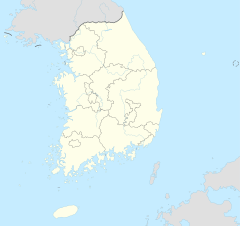| Anti-appeasement Stele | |
|---|---|
척화비 | |
 Cheongju Anti-appeasement Stele | |
| General information | |
| Type | stele |
| Architectural style | Korean |
| Town or city | Jongno District, Seoul |
| Country | South Korea |
| Coordinates | 37°34′43″N 126°58′38″E / 37.57861°N 126.97722°E |
| Current tenants | National Palace Museum of Korea National Folk Museum |
| Opened | 1871 |
| Korean name | |
| Hangul | 척화비 |
| Hanja | |
| Revised Romanization | Cheokhwabi |
| McCune–Reischauer | Ch'ŏk'wabi |
Anti-appeasement steles were 19th century monuments built in Korea to ostracize Westerners. They were erected by Heungseon Daewongun at more than 200 major transportation hubs across the country, including the four streets of Jongno. They were built in 1871 (the 8th year of reign by Emperor Gojong of the Joseon dynasty). They were made of granite and were four cubits high, five cubits wide, and eight inches thick.[1]
- ^ Yu, Yŏng-ik (2008). Early Korean Encounters with the United States and Japan: Six Essays on Late Nineteenth-century Korea. Royal Asiatic Society, Korea Branch. p. 98. ISBN 9788995442487.
